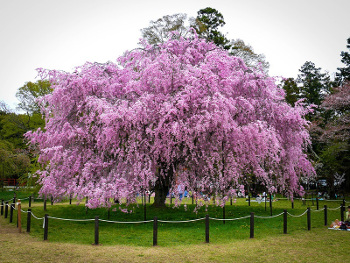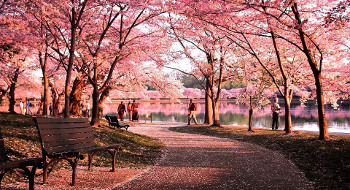The loved Flowering Cherry Trees belong to the genus named Prunus, which also includes plums, peaches, nectarines, apricots, and almonds. The Flowering Cherry Trees are grown throughout temperate regions of the world, most notably in eastern Asia, where much of the tree’s cultural significance originated. Many of the species within this grouping are hybrids and cultivars, and the Royal Horticultural Society has awarded many of these trees with the Award of Garden Merit.
Flowering Cherries are valued for their springtime blossoms, which has led to the cherry blossom picnic tradition known as ‘Hanami’ among the Japanese cultural history. There are over 430 species of Flowering Cherries, some of which have been dated to as far back as 44.3 million years ago. Flowering Cherry Trees are now known throughout much of the United States, with the capitol city, Washington D.C., initiating its own ‘Cherry Blossom Festival’ in early spring. The flowers are typically white or light pink, though vibrant pinks and yellowish blooms are not uncommon.
Researching a tree and its needs prior to purchasing and planting is an important investment. Trees have specific needs, especially in regards to sun exposure, watering needs, and seasonal adjustments. Read the quick facts below before researching the Flowering Cherry Tree in more depth in the following sections to determine if this ornamental tree is the right fit for the given planting location.
Flowering Cherry Trees add ornamental beauty to a landscape, but this is only if the trees are well-cared for during the initial stages of growth. The Tree Center brings this love and care to the growing Flowering Cherry Tree saplings. Once the specific species has been determined, buying the Flowering Cherry Tree from The Tree Center will help ensure successful growth during the later stages of development.
Sun: Plant in full sun. Partial afternoon shade can also be beneficial.
Water: Water immediately after planting and twice per week for the first year (every 7 days) to a depth of about 2 feet.
When to Plant: Plant in mid to late autumn.

After the tree arrives, observe the size of the tree’s root ball. This is the collection of roots at the base of the Flowering Cherry Tree’s trunk. The size of the hole in which the tree will be planted should be three times wider than the root ball. The hole should be slightly less deep than the height of the root ball, since the Flowering Cherry Tree will settle an inch or two over time.
Dig the hole for the Flowering Cherry Tree in a location with well-draining soil and full sun. Hold the tree vertically in the hole while backfilling the hole with soil and water. Once the tree is secured, add mulch and fertilizers if using these products.
Next, water the tree immediately for approximately 30 minutes or with a proper irrigation system dispersing approximately 3 gallons of water over a 3-foot radius surrounding the tree. Water the tree twice a week for the first six months after planting.
The soil is responsible for carrying valuable resources and nutrients through the dirt to the Flowering Cherry Tree’s root system. Soil comes in a variety of types, and these different categorizations are based around particle size. There are three main categories: clay, silt, and sand. Clay and silt are made up of small particles. These often block the easy movement of water and air. Additionally, once these soils are saturated, run-off will occur.
On the other hand, sand is made up of larger soil grains. These grains move water and air quickly through the soil, so quickly, in fact, that the Flowering Cherry Tree’s root systems are unable to absorb enough resources. Loam is the best soil, as it combines a variety of particle sizes, decreasing the negatives of each type and increasing the positives. Soils can also be characterized by their pH level (acidic or basic) and mineral composition. Flowering Cherry Trees are adaptable to poor soils; however, they much prefer well-draining acidic soils with loamy soil.
Flowering Cherry Trees grow best with moderate to heavy access to water; however, many landscapers are successful in growing Flowering Cherry Trees throughout the driest regions of the United States, in the Southwest. Most species do not grow well in the Upper Midwest. Flowering Cherry Trees require watering frequently, especially in lieu of natural water availability. Immediately after planting, water the tree immediately for 30 minutes with a hose. Irrigation systems can also be helpful at encouraging proper watering, as these will disperse water in low-pressure amounts. For those areas struggling with droughts, these systems can also assist in water conservation.
Mulches and fertilizers can be used to increase the success and growth rate of the Flowering Cherry Tree. These act to increase the water conservation, nutrient matter, and access of air and water to the root systems. Mulch is an almost essential tool when planting and growing Flowering Cherry Trees.
Place a three inch layer of mulch in a three foot radius around the base of the tree. Natural based mulches, such as those made of wood chips or bark, are best. Mulch will help in the permeation of water into the soil. Fertilizers are not always necessary when planting trees; however, Flowering Cherry Trees can benefit from slow-release, well-balanced fertilizers, such as those labeled 10-10-10 or 8-8-8.

Although Flowering Cherry Trees can be planted as individual accent trees in small gardens, rows can be planted to create flowering hedges or, if planted on either side of the road, a blossoming tunnel.
There are about 430 species within the larger genus, Prunus. However, only a few of these are flowering cherry trees. Moreover, not all grow well in the United States. The species listed below are available at The Tree Center and grow well in USDA Hardiness Zones 4 to 9.
The White Weeping Cherry has a cascading silhouette, as the boughs of the tree bend towards the ground, sweeping the grass with its namesakes white blossoms. The flowers of the White Weeping Cherry blossom in spring, though its hardy nature makes it a popular tree throughout the growing season. Expect a height of between 20 and 30 feet, and easy growth in USDA Hardiness Zones 5 through 8.
Prized for its cold hardy ability, the Autumn Cherry Tree offers white blossoms in springtime. This Flowering Cherry Tree is also drought tolerant. Adaptable and tolerant of poor soils, the Autumn Cherry Tree reaches heights between 20 and 40 feet and is hardy in USDA Hardiness Zones 4 through 8.
The Kwanzan Cherry is a hardy tree, offering vibrant pink to almost lavender-shaded blossoms. This species of Flowering Cherry Tree can reach between 30 and 40 feet tall with a spread of between 30 and 40 feet. Hardy, somewhat drought tolerant, and relatively adaptable to poor soil condition, the Kwanzan Cherry Tree is hardy in USDA Hardiness Zones 5 through 9.
The Yoshino Cherry has ivory-white to pale yellow blossoms, which are adaptable to a variety of soil conditions. The Yoshino Cherry Tree is one of the species most commonly found throughout Washington D.C. Expect heights between 20 to 30 feet and spreads of between 10 and 20 feet. The Yoshino Cherry Tree is hardy in USDA Hardiness Zones 5 through 8.
Landscapers often choose Flowering Cherry Trees for their ornamental qualities. Unlike the showy Crape Myrtles, Flowering Cherry Trees are relatively cold-hardy and tolerant of various soil conditions. Furthermore, the blossoms are subdued, offering simplicity to the gardener. Flowering Cherry Trees are also easy to care for.
There are a few species of pests and fungus that affect Flowering Cherry Trees specifically, such as gummosis. The aphid species known as Damson-hop aphids, or Phorodon humuli, are hosted by the Flowering Cherry tree. These aphids go on to destroy the popular crop, hops. Other concerns that may arise throughout the care of the Flowering Cherry Tree include the fungi brown rot, powdery mildew, and cherry leaf spot. Additionally, Black Cherry Aphids can eat the leaves of the plant.





